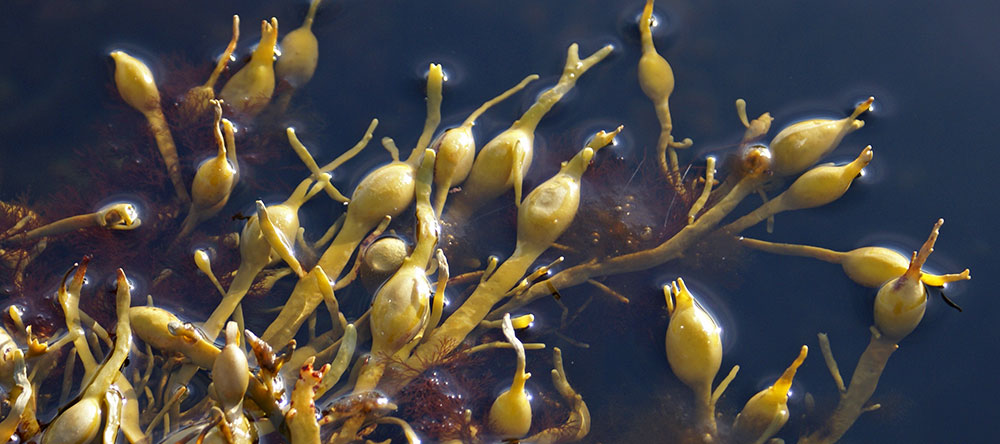For centuries, agricultural areas near the sea used seaweed as a valuable source of organic matter to fertilise their fruit and vegetable crops. But over time, it has been shown that products with seaweed extracts are increasingly the subject of attention as nutritional supplements in the agronutrients. In fact, seaweed extracts currently make up a specialty in our agricultural biostimulants catalogue.
Of all the marine seaweed existing in the market, the Ascophyllum nodosum seaweed and its properties, has been the most researched and used in agriculture. This seaweed, also known as Norway’s Laminaria, grows in abundance in coastal areas, areas regularly covered by high and low tides.
Research, in private industrial centers and universities, has demonstrated the great benefits using Ascophyllum nodosum extracts to improve aspects of crop such us growth and development.
What role does Ascophyllum nodosum extract do?
Among the beneficial effects attributed to the Ascophyllum nodosum extracts is the presence of natural growth hormones, the same ones that synthesize the plants, such as: cytokinins and auxins , in addition to plant biostimulants such as betaine , polyamine , oligosaccharides, which can increase the plant resistance and tolerance to various pests and diseases.
Seaweed extracts catalogue
In our agricultural biostimulants catalogue, within the specialty of seaweed extracts, you can find our liquid and solid formulated.
Liquid Ascophyllum nodosum seaweed extract
Our product Algadul, contains a high concentration of pure Ascophyllum nodosum extract (24% w/w), contributing nutrients and growth inductors to the plants.
The main nutrients that it contributes are: nitrogen, phosphorus and potassium as well as a large variety of secondary elements and trace elements such as: magnesium, calcium, manganese, zinc, boron, etc., plant biostimulants such as: mannitol, alginic acid, laminarin… and amino acids: glutamic acid, alanine, phenylalanine, glycine, proline, lysine, etc. It also contains cytokinins, mainly zeatin, which has a great biological activity.
Algadul is within our range of ecological fertilisers and can be used in all types of crops: conventional as well as organic farming. It can be applied by foliar application or by any irrigation system.
Biostimulant with Ascophyllum nodosum for flowering and fruit setting
Jisamar is our liquid biostimulant formulated to promote flowering and fruit setting containing seaweed extracts Ascophyllum nodosum and amino acids.
It’s an especially developed formulated for its foliar application that in addition to the active substances before mentioned it also incorporates NPK. Its richness in natural phytohormones of plant origin such as cytokinins, auxins and gibberellins, together with the phosphorus of its composition, makes it is also very effective for the ripening of fruits in addition to being indicated for flowering and fruit setting.
100% solid seaweed Ascophyllum nodosum extracts
The agricultural biostimulant Ascofillum is our solid formulated based on 100% Ascophyllum nodosum. It’s an ecological biostimulant rich in natural auxins and cytokinins.
Ascofillum contains natural elements that stimulate the plant in its physiological processes among which are the stimulation of cellular processes, slowing the aging process of the cells of the leaves. After its application in the plant it causes a reactivation of its metabolism and an increase in photosynthetic capacity, responses that help it to overcome moments of stress due to temperatures or an excess or lack of water.
Ascofillum can be applied by foliar and root application. It is recommended to apply together with other JISA nutritional products to take advantage of its biostimulant effect in the different phenological phases of the crops.

Did you know …? How Ascophyllum nodosum plant is
The Ascophyllum nodosum is an algae called ‘brown seaweed’ and popularly known as Norwegian laminaria, rock algae or Norwegian kelp for example. It is unique in its species within the genus Ascophyllum and belongs to the Fucaceae family.
This seaweed lives on the American and European coasts bathed by the North Atlantic Ocean. Normally on rocky areas of the shores of the coast and it does so that it can cover large spaces although its growth is slow. Each plant can live around 14 years.
As a plant, Ascophyllum nodosum develops long branches (fronds) of irregular shape in which it contains small nodules in the form of bladders with air inside that help its buoyancy. Its fronds, (the only large leaf that have some plants, such as ferns), olive green and/or slightly brown, can reach two meters in length. These are fastened to the rocks of the coast by means of a rhizoid, organ that exerts the functions of root without having the structure of them.
In relation to the chemical composition of Ascophyllum nodosum, its extracts are referenced once it’s processed. Among them, there are essential nutrients such as nitrogen, phosphorus and potassium, as well as a great variety of secondary elements and trace elements such as magnesium, calcium, manganese, zinc, boron, etc.; natural growth hormones such as cytokinins and auxins in addition to zeatin which is of great biological activity; biostimulants such as betaines, polyamines, oligosaccharides, mannitol, alginic acid, laminarin… and amino acids such as glutamic acid, alanine, phenylalanine, glycine, proline, lysine, etc.
Images of Ascophyllum nodosum: Wikipedia



